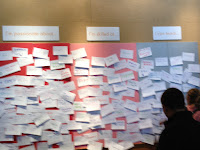I was speaking to someone (Greg) last night who works for a company that works with libraries. He'd like to set up a time his group to interact with library and information science students, and I'm happy to comply. This morning, my mind started thinking about what that meeting (lunch) might entail and an exercise from the
R-Squared Conference came to mind. I'm using this blog post to document my idea, not only to share it with him, but also so you might use it too.

At this lunch event, I would like to gather as many of this organization's employees as possible. Then I would like invite two students for each employee. (So twice as many students as employees.) Why? Students are used to thinking creatively and I want to "up" the creative thinking in the room, but not totally overwhelm this organization's employees.
When participants "sign in", I would ask them to put their name and their favorite animal on their name tag. This will give people something to immediately discuss, especially if I tell them their their favorite animal can't be a dog or a cat (easy choices).
Participants would be encouraged to sit at tables were there are at least two employees and four students. Each table would have a big piece of butcher paper (or newsprint paper) with markers, pens, and crayons. Once settled in - and perhaps after eating lunch -
each table would be assigned a brand (e.g., Apple, Chuck E. Cheese, Disney, Las Vegas, or Starbucks) and would use that brand's point of view to brainstorm these questions:
- What would a new library look like?
- What services would it have?
- Who would use it?
- How would it function?
- When would it be open?
- Where would it be located?
Participants would first be encourage to quickly share what they know about the brand, then move into the questions. With a big piece of paper in front of them, they could write or draw their answers.
They would be encourage to come up with one vision per table - based on the brand that they were assigned - but individuals could capture ideas that didn't included in the final vision. (Those notes could be interesting to review later.)
That 10-15 minute brainstorming session would be followed by a debriefing where each table would present its ideas. We would mark those components that resonated with others in the room. All of the notes would be captured for later use (including photos of the drawings, etc.).

When
we did a similar exercise during R-Squared, my table was tasked with designing a Starbucks influenced library. The hub/center of the library was the cafe, with music/media being close to
the cafe, then the books. Music is piped into the space. Seating is
comfortable in order to encourage people to linger. People can download
media easily, including ebooks. People can even download parts of
ebooks, which means they can select specific chapters that they want to
read. In addition, people can combine books with music, so that a book
could have a specific soundtrack.
The
library would have extended hours, opening early and staying open late.
And it would be a kid-free zone. This is keeping the way people use
Starbucks, where you don't find kids hanging out. It is a place for
adults only.
We didn't talk in detail about what furnishings and other stuff would be in the library and I wish that we had. I think it would have been good to talk about the environment on that level.
Okay...now that I've gotten this written, time to spring my idea on Greg!













